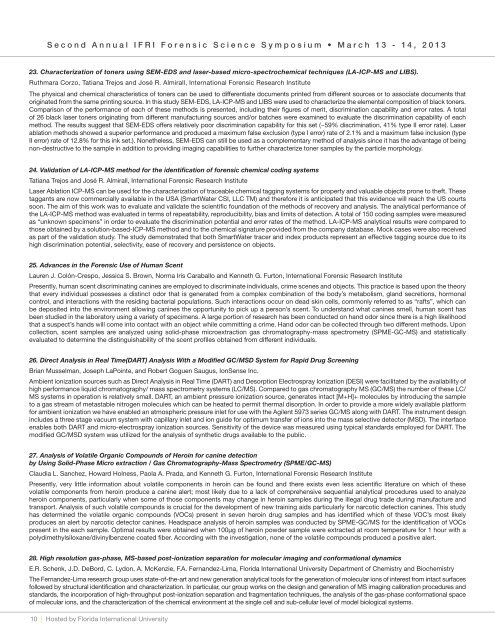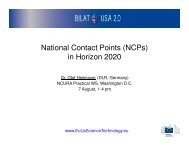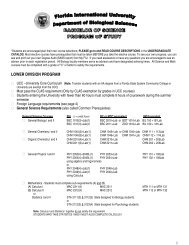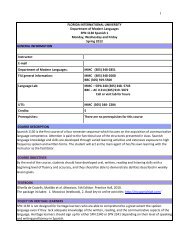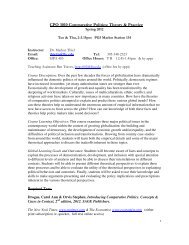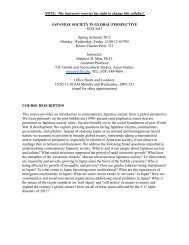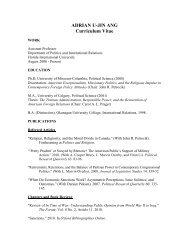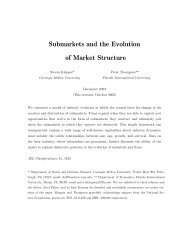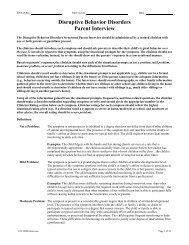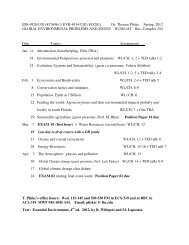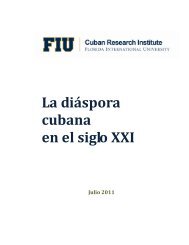Second Annual IFRI Forensic Science Symposium - College of Arts ...
Second Annual IFRI Forensic Science Symposium - College of Arts ...
Second Annual IFRI Forensic Science Symposium - College of Arts ...
You also want an ePaper? Increase the reach of your titles
YUMPU automatically turns print PDFs into web optimized ePapers that Google loves.
<strong>Second</strong> <strong>Annual</strong> <strong>IFRI</strong> <strong>Forensic</strong> <strong>Science</strong> <strong>Symposium</strong> • March 13 - 14, 2013<br />
23. Characterization <strong>of</strong> toners using SEM-EDS and laser-based micro-spectrochemical techniques (LA-ICP-MS and LIBS).<br />
Ruthmara Corzo, Tatiana Trejos and José R. Almirall, International <strong>Forensic</strong> Research Institute<br />
The physical and chemical characteristics <strong>of</strong> toners can be used to differentiate documents printed from different sources or to associate documents that<br />
originated from the same printing source. In this study SEM-EDS, LA-ICP-MS and LIBS were used to characterize the elemental composition <strong>of</strong> black toners.<br />
Comparison <strong>of</strong> the performance <strong>of</strong> each <strong>of</strong> these methods is presented, including their figures <strong>of</strong> merit, discrimination capability and error rates. A total<br />
<strong>of</strong> 26 black laser toners originating from different manufacturing sources and/or batches were examined to evaluate the discrimination capability <strong>of</strong> each<br />
method. The results suggest that SEM-EDS <strong>of</strong>fers relatively poor discrimination capability for this set (~59% discrimination, 41% type II error rate). Laser<br />
ablation methods showed a superior performance and produced a maximum false exclusion (type I error) rate <strong>of</strong> 2.1% and a maximum false inclusion (type<br />
II error) rate <strong>of</strong> 12.8% for this ink set.). Nonetheless, SEM-EDS can still be used as a complementary method <strong>of</strong> analysis since it has the advantage <strong>of</strong> being<br />
non-destructive to the sample in addition to providing imaging capabilities to further characterize toner samples by the particle morphology.<br />
24. Validation <strong>of</strong> LA-ICP-MS method for the identification <strong>of</strong> forensic chemical coding systems<br />
Tatiana Trejos and José R. Almirall, International <strong>Forensic</strong> Research Institute<br />
Laser Ablation ICP-MS can be used for the characterization <strong>of</strong> traceable chemical tagging systems for property and valuable objects prone to theft. These<br />
taggants are now commercially available in the USA (SmartWater CSI, LLC TM) and therefore it is anticipated that this evidence will reach the US courts<br />
soon. The aim <strong>of</strong> this work was to evaluate and validate the scientific foundation <strong>of</strong> the methods <strong>of</strong> recovery and analysis. The analytical performance <strong>of</strong><br />
the LA-ICP-MS method was evaluated in terms <strong>of</strong> repeatability, reproducibility, bias and limits <strong>of</strong> detection. A total <strong>of</strong> 150 coding samples were measured<br />
as “unknown specimens” in order to evaluate the discrimination potential and error rates <strong>of</strong> the method. LA-ICP-MS analytical results were compared to<br />
those obtained by a solution-based-ICP-MS method and to the chemical signature provided from the company database. Mock cases were also received<br />
as part <strong>of</strong> the validation study. The study demonstrated that both SmartWater tracer and index products represent an effective tagging source due to its<br />
high discrimination potential, selectivity, ease <strong>of</strong> recovery and persistence on objects.<br />
25. Advances in the <strong>Forensic</strong> Use <strong>of</strong> Human Scent<br />
Lauren J. Colón-Crespo, Jessica S. Brown, Norma Iris Caraballo and Kenneth G. Furton, International <strong>Forensic</strong> Research Institute<br />
Presently, human scent discriminating canines are employed to discriminate individuals, crime scenes and objects. This practice is based upon the theory<br />
that every individual possesses a distinct odor that is generated from a complex combination <strong>of</strong> the body’s metabolism, gland secretions, hormonal<br />
control, and interactions with the residing bacterial populations. Such interactions occur on dead skin cells, commonly referred to as “rafts”, which can<br />
be deposited into the environment allowing canines the opportunity to pick up a person’s scent. To understand what canines smell, human scent has<br />
been studied in the laboratory using a variety <strong>of</strong> specimens. A large portion <strong>of</strong> research has been conducted on hand odor since there is a high likelihood<br />
that a suspect’s hands will come into contact with an object while committing a crime. Hand odor can be collected through two different methods. Upon<br />
collection, scent samples are analyzed using solid-phase microextraction gas chromatography-mass spectrometry (SPME-GC-MS) and statistically<br />
evaluated to determine the distinguishability <strong>of</strong> the scent pr<strong>of</strong>iles obtained from different individuals.<br />
26. Direct Analysis in Real Time(DART) Analysis With a Modified GC/MSD System for Rapid Drug Screening<br />
Brian Musselman, Joseph LaPointe, and Robert Goguen Saugus, IonSense Inc.<br />
Ambient ionization sources such as Direct Analysis in Real Time (DART) and Desorption Electrospray Ionization (DESI) were facilitated by the availability <strong>of</strong><br />
high performance liquid chromatography/ mass spectrometry systems (LC/MS). Compared to gas chromatography MS (GC/MS) the number <strong>of</strong> these LC/<br />
MS systems in operation is relatively small. DART, an ambient pressure ionization source, generates intact [M+H]+ molecules by introducing the sample<br />
to a gas stream <strong>of</strong> metastable nitrogen molecules which can be heated to permit thermal disorption. In order to provide a more widely available platform<br />
for ambient ionization we have enabled an atmospheric pressure inlet for use with the Agilent 5973 series GC/MS along with DART. The instrument design<br />
includes a three stage vacuum system with capillary inlet and ion guide for optimum transfer <strong>of</strong> ions into the mass selective detector (MSD). The interface<br />
enables both DART and micro-electrospray ionization sources. Sensitivity <strong>of</strong> the device was measured using typical standards employed for DART. The<br />
modified GC/MSD system was utilized for the analysis <strong>of</strong> synthetic drugs available to the public.<br />
27. Analysis <strong>of</strong> Volatile Organic Compounds <strong>of</strong> Heroin for canine detection<br />
by Using Solid-Phase Micro extraction / Gas Chromatography-Mass Spectrometry (SPME/GC-MS)<br />
Claudia L. Sanchez, Howard Holness, Paola A. Prada, and Kenneth G. Furton, International <strong>Forensic</strong> Research Institute<br />
Presently, very little information about volatile components in heroin can be found and there exists even less scientific literature on which <strong>of</strong> these<br />
volatile components from heroin produce a canine alert; most likely due to a lack <strong>of</strong> comprehensive sequential analytical procedures used to analyze<br />
heroin components, particularly when some <strong>of</strong> those components may change in heroin samples during the illegal drug trade during manufacture and<br />
transport. Analysis <strong>of</strong> such volatile compounds is crucial for the development <strong>of</strong> new training aids particularly for narcotic detection canines. This study<br />
has determined the volatile organic compounds (VOCs) present in seven heroin drug samples and has identified which <strong>of</strong> these VOC’s most likely<br />
produces an alert by narcotic detector canines. Headspace analysis <strong>of</strong> heroin samples was conducted by SPME-GC/MS for the identification <strong>of</strong> VOCs<br />
present in the each sample. Optimal results were obtained when 100µg <strong>of</strong> heroin powder sample were extracted at room temperature for 1 hour with a<br />
polydimethylsiloxane/divinylbenzene coated fiber. According with the investigation, none <strong>of</strong> the volatile compounds produced a positive alert.<br />
28. High resolution gas-phase, MS-based post-ionization separation for molecular imaging and conformational dynamics<br />
E.R. Schenk, J.D. DeBord, C. Lydon, A. McKenzie, F.A. Fernandez-Lima, Florida International University Department <strong>of</strong> Chemistry and Biochemistry<br />
The Fernandez-Lima research group uses state-<strong>of</strong>-the-art and new generation analytical tools for the generation <strong>of</strong> molecular ions <strong>of</strong> interest from intact surfaces<br />
followed by structural identification and characterization. In particular, our group works on the design and generation <strong>of</strong> MS imaging calibration procedures and<br />
standards, the incorporation <strong>of</strong> high-throughput post-ionization separation and fragmentation techniques, the analysis <strong>of</strong> the gas-phase conformational space<br />
<strong>of</strong> molecular ions, and the characterization <strong>of</strong> the chemical environment at the single cell and sub-cellular level <strong>of</strong> model biological systems.<br />
10 | Hosted by Florida International University


